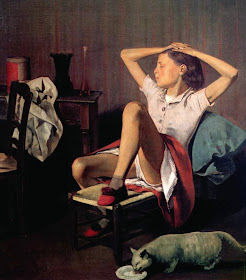In the last
month I have thought about Dosso Dossi more than I have in five years studying
art history. Dosso Dossi is a Renaissance painter who was positioned in the court
of Ferrara. Ferrara was one of the centres of Renaissance culture and was also
home to the infamous Lucrezia Borgia (her third husband was the Duke of
Ferrara). I also know Dosso as the owner of the coolest signature known to art history: the letter ‘D’
crossed with a bone (osso), together
they are read as D-osso!
Unfortunately
art history does not remember his with the same excitement. In his day he was
overshadowed by titans of Renaissance such as Titian, Da Vinci, Michelangelo,
Raphael. Therefore it is no surprise that Vasari described him as second best in Lives of the Artists, unfortunately Vasari’s view
was so authoritative that it was not questioned until recently. Despite this, Dosso Dossi’s
work can be found in many major museums and the work that I cannot get out of
my head hangs in the National Gallery in London, it is called
Lamentation over the Body of Christ.
The small image shows the dead body of the Christ lying on the ground after having been taken of the cross. The body is surrounded by three women. One is at his feet, the second is kneeling at his head, and the third
stands behind his head staring into the sky and holding her head. The gestures
of all three are theatrical and hyperbolised. What makes the works both
awkward and striking is the distortion of the anatomical proportions of the figures.
For example the kneeling down woman has an proportionately small head and large
arms. The awkwardness, the clumsiness of big gestures and poses, the physical distortions all make this scene look like something Diane Arbus would have
been interested in photographing especially as part of her later series.
.JPG) |
| Dosso Dossi, Saint Jerome, c.1519, oil on canvas, Kunsthistorisches Museum, Vienna. (Detail) |
Lamentation over the Body of Christ.
 |
| Dosso Dossi, Lamentation over the Body of Christ, 1510-1520, oil on wood, National Gallery, London. |
 |
| Diane Arbus, Untitled (6), 1970-71; © The Estate of Diane Arbus |
The reason why I became interested in the Lamentation over the Body of Christ is because two very different and
two very surprising artists referenced him as an influence. The first of these
is John Currin. Currin is a great contemporary artist who is well known for his
oil paintings of young women.
I always thought that aesthetically Currin's work is somewhere between Balthus (sans the cats and the pedophilic vibe) and the 'girlishness' shown in the Sofia Coppola movies.
As you have noticed, I used 20th century references to
describe Currin's work, so it was a bit of a shock to find out that an obscure Renaissance
artist is one of the influencers. I heard Currin talk about Dosso during one of the
Frieze Masters talks last month. Currin explained that the great names of Renaissance
always intimidated him, and he felt that he cannot learn from them. There is no
point of copying Raphael, as no matter how good you are you are never going to be
as good as Raphael. On the other hand, the ‘second tier’ artists were less
intimidating, and one could actually approach their work and learn. And of
course there is the quirkiness of the image, the distortions that make the image
very compelling and accessible, it is less intimidating to approach it and to learn from it. (For the full talk visit http://friezemasters.com/talks/john-currin-in-conversation-with-letizia-treves/)
 |
| John Currin, Thanksgiving, 2003, oil on canvas, Tate, London. |
 |
| Balthus, Thérèse dreaming, 1938, oil on canvas |
 |
| The Virgin Suicides, 1999 |
Interestingly,
the second artist became interested in the painting also for its distortions.
The second artist is Michael Landy a Young British Artist (YBA) who is more famous for destroying
rather than creating. His most famous work to date is Break Down where over a few days he destroyed everything he owned including his birth
certificate and passport.
A few years ago he took up residency in the National
Gallery and during the early stages of his research and exploring the gallery
he made copies of a few artworks one of them was Dosso’s Lamentation. The distortions were
what interested Landy in this work and when he copied the work he also copied the defects acquired with age – the cracks in the paint. He also enlarged the work making it almost 2 meters high.
I must admit that Dosso Dossi serving as a muse to two very different and very good artists makes me very happy as it shows that the Renaissance is still relevant and that it serves as an inspiration to today's artists. It shows that artists' are not afraid to venture outside the established canon, and that people who say that contemporary artists don't know anything about art are ill informed.
 |
| Michael Landy, Break Down, 2001, exhibition view. |
.JPG) |
| Michael Landy, Lamentation over the Body of Christ (after Dosso Dossi), 2011, watercolour pencil on paper, Duerckheim Collection. |